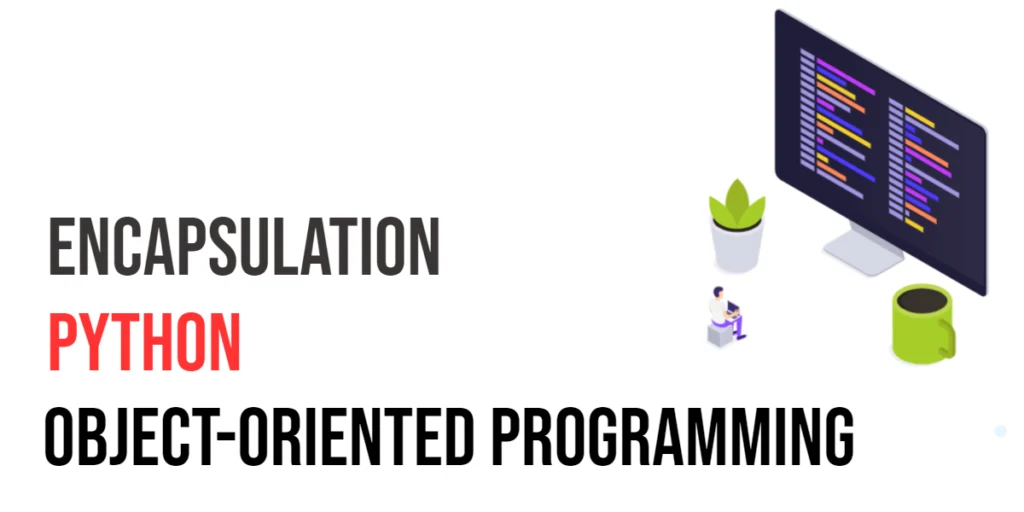Object-oriented programming (OOP) is like a blueprint for building software. Imagine you’re assembling a toy car from a kit. Each part of the car, like the wheels, body, and engine, represents an “object” in programming. These objects include both characteristics (data fields) and actions (methods) that they can perform, much like how the wheels can roll and the engine can start.

with hands-on learning.
get the skills and confidence to land your next move.
Python is a flexible programming language that embraces this approach, making it easier for developers to solve real-world problems by building applications as collections of these objects. In this article, we’re going to explore a key concept of OOP in Python known as encapsulation.
Encapsulation is a technique used to bundle the data (attributes) and the methods (functions) that manipulate the data into a single unit, or class. By doing this, encapsulation helps keep each object’s data safe and secure from unwanted changes, much like how a locked door can keep your belongings safe inside your home. Let’s dive deeper into how Python uses encapsulation to help us write cleaner and more efficient code.
What is Encapsulation?
Encapsulation is a key concept in object-oriented programming, a style of coding that groups together data and the methods that work with that data into single units called classes. Think of encapsulation as the process of packing your most important possessions into a suitcase when you travel. Everything you need—like clothes and toiletries—is contained within a neat, secure package that keeps your items organized and safe.
In programming, encapsulation has a similar role:
- Protection: Just as a suitcase protects your belongings from being lost or damaged, encapsulation protects an object’s data from being accessed or altered directly by outside code.
- Control: It allows for controlled access to that data, much like having a lock on your suitcase. Only through specific methods can external code interact with the protected data.
- Simplicity and Order: It keeps the structure of the program neat and manageable, making complex code easier to work with and understand.
This concept not only helps in safeguarding the information but also ensures that the software is modular, meaning it is designed in such a way that each part handles specific operations and can be maintained separately. This modular design is crucial for managing large applications and makes it easier to update and fix bugs without affecting other parts of the program.
By using encapsulation, programmers can create a clear structure for manipulating data that maintains the integrity of the data and the actions performed on it, making their code not just functional but also clean and intuitive.
How Does Python Implement Encapsulation?
In Python, encapsulation is like putting your most valuable items in a safe. It involves packaging the data (variables) and the functions (methods) that work with the data into a single unit called a class. This technique helps protect the data from external interference and misuse, similar to how a safe protects your valuables.
Access Levels in Python: Public, Protected, and Private
Python handles encapsulation differently than some other languages, such as Java. It uses three types of access modifiers to control how data and methods are accessed from outside the class:
- Public attributes/methods: These are the most accessible and can be used by anyone. They are like items in a glass case in a store, where customers can see and interact with them directly.
- Protected attributes/methods: These are intended to be accessible only within their own class and subclasses. They are denoted with a single underscore _ before their name. Think of these like items in a back room of a store, where only employees can go.
- Private attributes/methods: These are meant to be hidden from the outside entirely, used only within the class itself. They start with a double underscore __ and are like having items in a locked safe at home. Even if someone has access to your house, they can’t get into the safe without the key.
Practical Example: Managing a Bank Account
To see encapsulation in action, let’s consider a Account class, which acts as a model for a bank account:
class Account:
def __init__(self, owner, balance=0):
self.owner = owner
self.__balance = balance # Private attribute
def deposit(self, amount):
if amount > 0:
self.__balance += amount
print(f"Added {amount} to the balance")
else:
print("Deposit amount must be positive")
def withdraw(self, amount):
if amount > 0 and amount <= self.__balance:
self.__balance -= amount
print(f"Withdrew {amount} from the balance")
else:
print("Invalid withdrawal amount")
def show_balance(self):
print(f"Current balance: {self.__balance}")In this example, the balance of the account is hidden from external access (__balance). Only the methods within the class (deposit, withdraw, show_balance) can directly interact with it:
# Using the Account class
acc = Account("John")
acc.deposit(100)
acc.withdraw(50)
acc.show_balance() # Shows the current balanceIf you try to access the balance directly from outside the class, Python will prevent you:
print(acc.__balance) # Error: 'Account' object has no attribute '__balance'Getters and Setters for Safe Access
Sometimes, you may need to provide a way to safely interact with private data. This is where getter and setter methods come in:
class Account:
def __init__(self, owner, balance=0):
self.owner = owner
self.__balance = balance
def get_balance(self):
return self.__balance
def set_balance(self, amount):
if amount < 0:
print("Balance cannot be negative.")
else:
self.__balance = amount
print(f"Balance updated to {amount}")This arrangement lets you embed rules for how data is accessed or modified, ensuring that the balance cannot be set to a negative number:
# Using getters and setters
acc = Account("Jane")
print(acc.get_balance()) # 0
acc.set_balance(200) # Balance updated to 200Why Encapsulation Matters
Encapsulation is a powerful tool in programming because it:
- Protects data: It keeps the data safe from unintended changes.
- Encapsulates complexity: Users of the class do not need to understand the details of how data is maintained.
- Improves maintainability: Changes to the class can be made with minimal impact on the code that uses it.
Understanding and implementing encapsulation can make your Python programming cleaner, more secure, and easier to manage. As you continue to explore OOP, you’ll find encapsulation to be an essential technique in creating robust and scalable software.
Conclusion
Encapsulation stands as one of the pillars of Object-Oriented Programming (OOP), offering a robust shield for data. It’s akin to putting our valuables in a safe; it prevents external factors from tampering with the inner workings of our code. In Python, this safeguarding technique ensures that your code behaves in expected ways, enhancing both security and reliability.
In Python’s universe, every element in a class starts off as public, meaning it’s accessible from anywhere. However, you can set boundaries using underscore prefixes. This is like setting rules in your game; you decide who plays, who pauses, and who stops. Using underscores (_ for protected and __ for private) before variable names, you can control what data and methods are available for use outside of your class definitions.
Integrating these practices isn’t just about following rules—it’s about crafting code that’s cleaner and more error-resistant. This approach doesn’t merely make your code work well; it aligns it with the way solutions are constructed in the real world, where safety and precision matter.
Dive into the examples provided, tweak them, and experiment. Each adjustment gives you more insight into how encapsulation can be effectively leveraged in Python to make your programs not only function but flourish. With every step, you’ll move closer to becoming a proficient Python programmer, capable of solving real-world problems with grace and efficiency. Keep exploring and let your curiosity guide you to new discoveries in coding!







